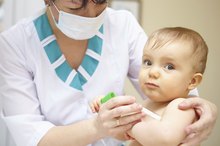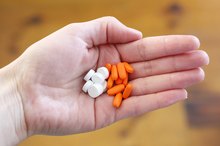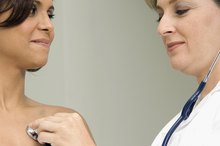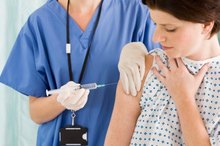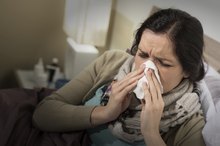Infant Flu Shot Side Effects
For the 2009-2010 flu season, the Food and Drug Administration approved two vaccines, Fluria and Fluzone, for administration in infants six months and older. No vaccine is approved for administration in infants younger than six months. As with adults, the infant flu shot is frequently associated with side effects you may wish to consider in scheduling your baby for vaccination.
If you are experiencing serious medical symptoms, seek emergency treatment immediately.
Injection Site Reaction
In infants, it is recommended that the flu shot be administered on the front outside of the thigh. In clinical studies for Afluria, injection site reaction was actually less common among younger children compared to older children. While redness and swelling are usually obvious, pain in infants is more difficult to identify and may be evidenced by fussiness, irritability and favoring the opposite extremity.
Flu-Like Illness
Flu Symptoms in a 16 Month Old
Learn More
In both adults and children, the flu shot is frequently associated with a flu-like illness. Compared to the true illness, symptoms are usually mild and brief. However, parents may want to consider this side effect in determining the appropriate time to schedule vaccination for their infants. In terms of severity, 78 percent of symptoms were rated by parents as mild, 19 percent were moderate and 3 percent were severe. Severe fever, defined as oral temperature greater than 104 degrees F or underarm temperature greater than 103.1 degrees F, was observed in less than 1 percent of children.
- In both adults and children, the flu shot is frequently associated with a flu-like illness.
- In terms of severity, 78 percent of symptoms were rated by parents as mild, 19 percent were moderate and 3 percent were severe.
Anaphylaxis
Anaphylaxis is a life-threatening allergic reaction that is a recognized complication of the flu shot. Anaphylaxis occurs on or after the second exposure to an allergen. Since infants receive two flu shots on separate occasions, anaphylaxis is theoretically more likely to follow the second injection.
Encephalomyelitis
Causes of Kids' Breathing Problems
Learn More
Acute disseminated encephalomyelitis (ADE) is a rare but severe side effect of the flu shot and several other vaccines including rabies, diptheria and polio. According to a 2008 study in the Journal of Clinical Neuroscience, ADE usually occurs in children, including infants. Fever usually resolves within a few weeks; however, neurological deficits persist for months and even years. ADE is extremely rare and is believed to involve an interaction between the flu shot and a person’s immune system.
- Acute disseminated encephalomyelitis (ADE) is a rare but severe side effect of the flu shot and several other vaccines including rabies, diptheria and polio.
- ADE is extremely rare and is believed to involve an interaction between the flu shot and a person’s immune system.
Related Articles
References
- American College of Allergy, Asthma, and Immunology
- Journal of Clinical Neuroscience; Post-Vaccination Encephalomyelitis: Literature Review and Illustrative Case; W. Huynh, D.J. Cordato, E. Kehdi, L.T. Masters and C. Dedousis; 2008
Resources
Writer Bio
Heather Gloria began writing professionally in 1990. Her work has appeared in several professional and peer-reviewed publications including "Nutrition in Clinical Practice." Gloria earned both a Bachelor of Science in food science and human nutrition from the University of Illinois. She also maintains the "registered dietitian" credential and her professional interests include therapeutic nutrition, preventive medicine and women's health.



